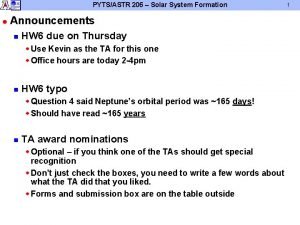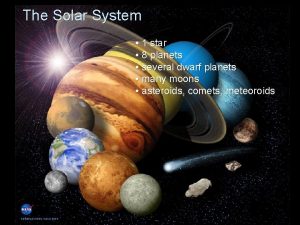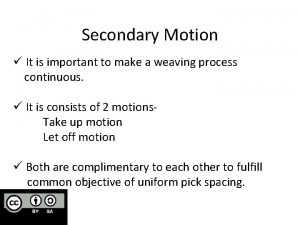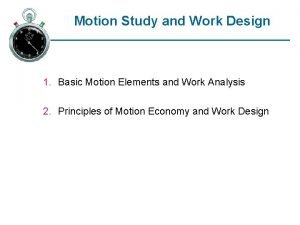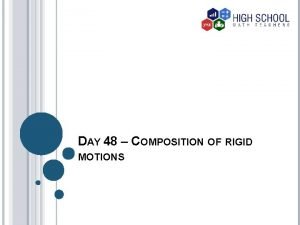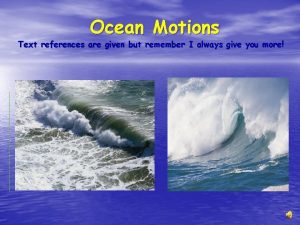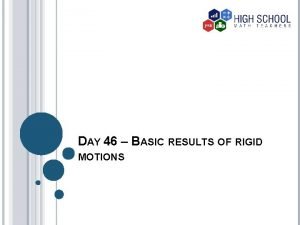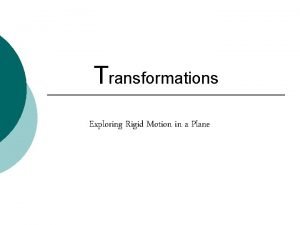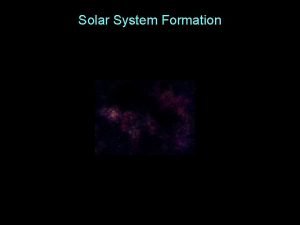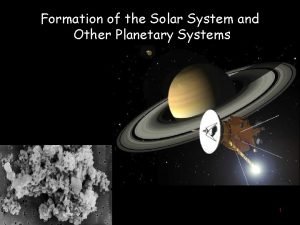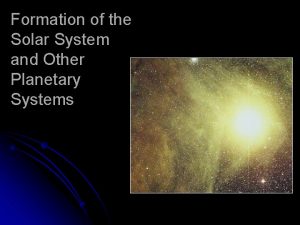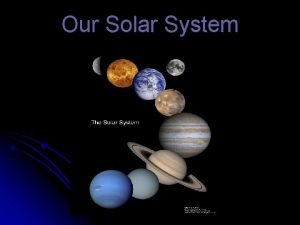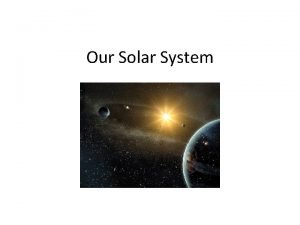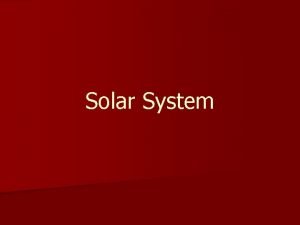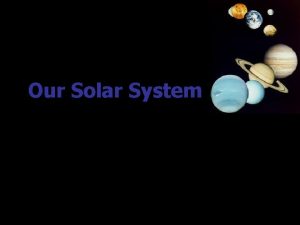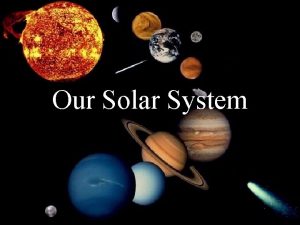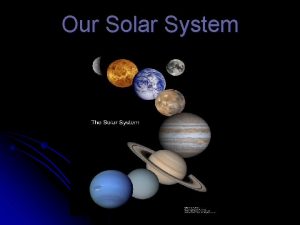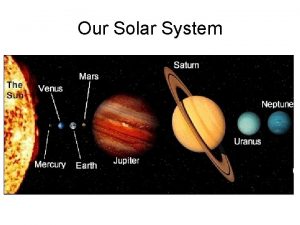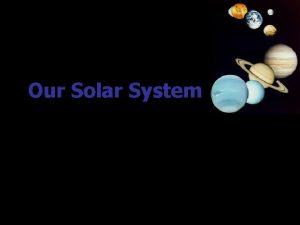The Formation of the Solar System Planetary motions

















- Slides: 17

The Formation of the Solar System

Planetary motions • The Sun, planets, asteroids, comets, planetesimals all revolve in the same direction with some exceptions. • Rotation axes usually perpendicular to orbital plane

Pluto


Planet-Planetesimal composition • Terrestrial Planets: • Cores Small & rocky (refractory elements, silicates & iron) • Atmospheres: Thin, no H/He, some ices or volatiles (C, N, O, Ne) • Jovian Planets: • Cores large rocks/metals/ices • Atmospheres H or H-compounds (e. g. CH 4) • KBOs: planetesimals and icy bodies: • Small ice & rock mixtures with frozen volatiles.

Icy Pluto Rocky Planets Giant Gas Planets Mostly H, He, & Ices

Primordial Gaseous nebula Gas cools and condenses gravitationally into a disk

Proto-Planetary Disks and Star Formation

Primordial Solar Nebula • Rotating solar nebula is composed of • ~74% Hydrogen & 25% Helium • Traces of metals and dust grains • Initially T~2000 K, gas cools to ice and dust according to condensation temperature

Condensation Temperatures T(K) Elements Compounds (oxides, silicates) >2000 K gases Ions: atoms, molecules 1400 K Iron & Nickel 1300 K Silicon, Sulfur Metal Grains (e. g. Fe 2 O 3) Silicate grains 300 K Carbonaceous grains 100 -300 K H, C, N, O Ices (H 2 O, CO 2, NH 3, CH 4)

Snow Line: Separation of Rocks/Metals from Gases/Ices • Rock & Metals form where T < 1300 K • Carbon grains & ices where T(gas) < 300 K • Inner planets and asteroids: Rocky and metallic • Snow line • Outer Jovian systems: Gaseous giants, carbon ices • Dust grains and ices collide, accrete, and eventually grow bigger gravitationally into planetesimals beyond the snow line


Life of the Sun • Burns or converts H He via theromonuclear fusion in core • When hydrogen in the core is exhausted, converted into helium, the H-burning shell moves outward and the star expands • H-burning phase for another 5 billion years; inert He-core • Stars in H-burning phase are said to be Main Sequence stars • Sun Red Giant • Eventually He in the core ignites helium flash • He-burning C/O (carbon, oxegen core) • Core separates from the envelope, which is ejected • Hot core and ejected envelope “Planetary Nebula” (star looks like a ring with bright center; nothing to do with planets) • Central core of planetary nebulae cools White Dwarf

Red Giant Star Inert He Core H Burning Shell Cool, Extended Envelope

Planetary Nebulae Sampler

Death of the Sun • Hot core continues as a white dwarf, about 60% mass of the Sun and size of the Earth • Gigantic diamond in the sky!

The Death of the Sun
 Formation of the solar system comic strip
Formation of the solar system comic strip Formation of the solar system
Formation of the solar system As the solar nebula contracts, it
As the solar nebula contracts, it The formation of the solar system
The formation of the solar system Wholesalesolar com solar panels
Wholesalesolar com solar panels Solar energy is free. solar is inexhaustible
Solar energy is free. solar is inexhaustible Five wheel take up motion
Five wheel take up motion Therblig
Therblig What is a composition of rigid motions
What is a composition of rigid motions Song leading
Song leading Ocean motions
Ocean motions Flow of debate mun
Flow of debate mun Basic rigid motions
Basic rigid motions Objectives of size separation
Objectives of size separation Dot translater
Dot translater True motions
True motions Ipmatc mnemonic
Ipmatc mnemonic Mimi garcia h
Mimi garcia h

